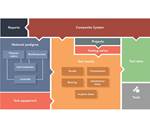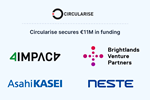Circularise digital passports contribute to PU foam recycling
Under the Circular Foam initiative creating systematic approaches for efficient rigid polyurethane (PU) foam recycling, Circularise’s DPPs are advancing secure information traceability for recycling and consumers.
Product traceability platform Circularise (The Hague, The Netherlands) announces significant advancements from its involvement in the Circular Foam project, which aims to optimize recycling of rigid polyurethane (PU) foam. Running from October 2021 to September 2025, the project brings together multiple industry leaders to address the recycling challenges posed by PU foam, a material widely used in construction, appliances and insulation, but also a critical structural core material used in the composites industry.
The Circular Foam initiative focuses on creating systemic, territorial approaches for efficient recycling. By 2040, the project is estimated to prevent 1 million tons of waste, reduce 2.9 million tons of CO2 emissions and save €150 million in incineration costs. Circularise is helping to test and refine solutions for large-scale implementation of circular PU foam recycling in order to formulate recommendations for scaling the solution throughout Europe.
Led by Covestro in collaboration with Circularise, Kinsgpan, Electrolux, Unilin and other key partners in Germany, Italy, Belgium and Ireland, the project focuses on overcoming the complexities of recycling PU foam, which offers significant energy-saving benefits but lacks standardization for effective recycling. Circularise says its role within the project has been pivotal in advancing product traceability through the development of digital product passports (DPPs). These passports enable secure, transparent data sharing across the entire value chain, enhancing the recyclability of PU foam products.
Circularise has successfully created DPPs for key products, including an Electrolux refrigerator door, a Unilin insulation board and a Kingspan metal panel. These DPPs capture vital data about product composition, sustainability certifications, and end-of-life (EOL) processes, ensuring that recyclers and consumers have the information they need to make informed decisions. This level of traceability has empowered recycling companies to access critical material and product data, enabling more efficient recycling processes and higher recovery rates.
Read “Life cycle assessment in the composites industry” for related content.
One of the most notable outcomes of the Circular Foam project is the ability to share confidential company data securely. Circularise’s platform uses blockchain technology and zero-knowledge cryptography to ensure that sensitive information, such as proprietary chemical compositions, is protected while still allowing companies to share essential details with the necessary stakeholders.
Consumers also benefit from Circularise’s innovation through the creation of public-facing Digital Product Passports (pDPPs). These QR-coded passports provide consumers with insights into a product’s lifecycle, from material composition to environmental impact. This feature enables environmentally conscious consumers to make informed purchasing decisions and supports the growing demand for transparency in sustainability.
Having finalised the work on DPPs and pDPPs in the Circular Foam Project, Circularise plans to extend its platform to other materials and industries.
Related Content
-
Plant tour: Middle River Aerostructure Systems, Baltimore, Md., U.S.
The historic Martin Aircraft factory is advancing digitized automation for more sustainable production of composite aerostructures.
-
Novel composite technology replaces welded joints in tubular structures
The Tree Composites TC-joint replaces traditional welding in jacket foundations for offshore wind turbine generator applications, advancing the world’s quest for fast, sustainable energy deployment.
-
Recycling end-of-life composite parts: New methods, markets
From infrastructure solutions to consumer products, Polish recycler Anmet and Netherlands-based researchers are developing new methods for repurposing wind turbine blades and other composite parts.













.jpg;maxWidth=300;quality=90)


